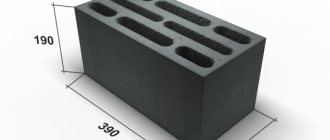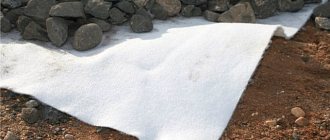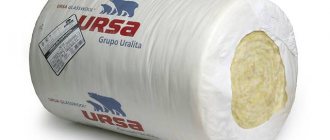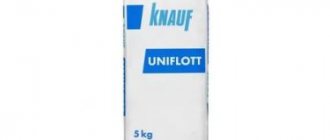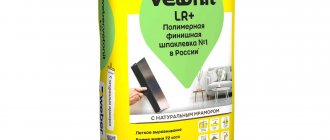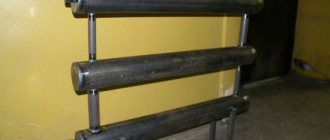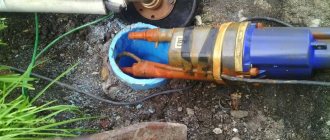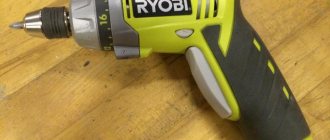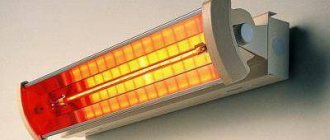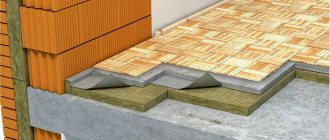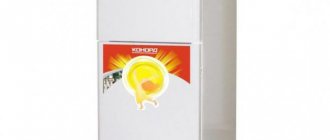Isolon - what is it?
This material is an elastic polyethylene foam with a closed-cell structure. In addition to the fact that isolon is hygienically and environmentally safe, it has an extensive range of insulating characteristics. Thanks to its cellular structure, foamed polyethylene practically does not absorb liquid and moisture, and also has a high level of heat and sound insulation.
For your information. Most often, foil-coated isolon is used for the home, which has a thin metallized coating on one or both sides. The use of foil significantly increases thermal insulation, which is due to the reflective properties of the material.
Foil polyethylene foam
Depending on the production technology, folgoizol is available in two types:
- cross-linked polyethylene foam (PPE);
- non-crosslinked polyethylene foam (NPE).
In the first option, polyethylene molecules are cross-linked together, thereby increasing the thermal insulation properties and achieving a longer service life. This process can be carried out both chemically and physically, each of which allows one to obtain the required parameters.
Non-crosslinked isolon has fewer chemical bonds, and therefore is inferior in characteristics to PPE. However, given the relatively simple production, its price is more attractive to the consumer.
Roll of foil insulation
Properties and technical specifications
The unique technical characteristics of folgoizolon set it apart from other building materials intended for insulation and sound insulation of various structures. Below are the main properties of isolon.
- High level of thermal insulation. The thermal conductivity coefficient of foil insulation is 0.031 W/mK, which is an excellent indicator when compared with other insulation materials. For example, the use of 10 mm thick isolon allows you to replace:
- 12 mm polystyrene foam;
- 45 mm wood or mineral wool;
- 150 mm bricks.
- Effective hydro-, steam- and sound insulation. The closed cell structure provides maximum resistance to the absorption of moisture and water vapor, and also prevents the penetration of sound waves. This characteristic is applicable even for a very thin layer.
- Elasticity and light weight. For construction purposes, foil isolon is produced in the form of sheets or rolls with a material density of 19-38 kg/m³. It is quite light and pleasant to the touch, and most importantly, it does not require the use of special tools for mechanical processing.
- Resistance to chemical products. An important characteristic of isolon is its resistance to oil, oil and gasoline. In addition, it is compatible with almost any building material: concrete, gypsum, lime, wood, etc.
- Long service life. Since this material is made on the basis of polymer raw materials, it is not susceptible to biological influence and, accordingly, to the process of decay. The service life without degradation is more than 80 years.
- Safety. In the production process of folgoizol, no toxic or harmful substances are used. It is odorless and can come into contact with human skin without any health consequences.
Advantages
The material in question, as a rule, is a layer of foamed polyethylene, covered on one side with aluminum foil:
Two layers of foil insulation: foil and polyethylene foam
As a result, we can talk about the following number of undeniable advantages inherent in this insulation:
- Excellent thermal insulation qualities . They are due to the low thermal conductivity of foamed polyethylene, which is 0.031 W/(m×K). So, if the thickness of foil insulation is 1 cm, then it insulates no worse than:
- 1.2 cm polystyrene foam;
- 4.5 cm wood;
- 15 cm brick;
- Cellular structure . How is it useful? The fact that it prevents steam, sound and moisture from penetrating through the material. That is, walls, floors or ceilings covered with the material in question will be protected from negative manifestations of dampness, and residents from the penetration of extraneous noise;
Due to its cellular structure, foil-coated isolon is also used as a waterproofing material
- Low weight . It is easy to install and transport with your own hands without the use of special equipment. In addition, it does not exert any pressure on the base;
Foil insulation does not require a serious fastening system when insulating the ceiling, since it weighs very little
- Chemical inertness . Resistant to gasoline, oil and oil. Compatible with any building materials: brick, wood, concrete, plaster, lime and so on;
Balcony insulation with foil insulation can be done directly onto the brick
- Durability . All components of the insulation under consideration are made from polymers. Consequently, they are not subject to decay processes and can last at least eighty years;
- Thermal reflective properties . In addition to the fact that foil-coated isolon does not allow heat to pass through, it also reflects thermal radiation due to the presence of a foil layer;
When installing foil insulation sheets, be sure to lay them with the foil surface inside the room. Otherwise, it will not reflect thermal radiation from heating sources.
Laying foil insulation must be done with the foil inside so that it can reflect thermal radiation back into the room
- Simple instructions for use . This thermal insulation material is sold in the form of mats or rolls, which can be easily unrolled and attached to any surface;
When installing foil insulation, do not forget to seal its joints with foil insulating tape to prevent thermal leaks.
Foil mounting tape is used to insulate the seams between foil-coated isolon sheets
- Versatility . It is used both for internal finishing works and for external ones. The self-adhesive version of the material in question is especially suitable for outdoor work; it does not require the use of additional adhesives during installation;
The photo clearly shows that foil-clad isolon can be used for thermal insulation of the roof from the outside
- Acceptable price.
Flaw
The most significant drawback worthy of mention is the soft structure of foil insulation, which makes it inconvenient to lay under the screed.
Life time
Since foil insulation appeared relatively recently, it is not yet possible to determine the exact expiration date. However, after conducting experiments, we can say that the material does not lose its properties for 200 years.
The service life of the installed insulation depends on the adhesive used. If the adhesive composition has passed its expiration date, then you can re-install it with the same heat insulator.
There are a lot of insulation materials on the construction market. The choice is so wide that the question arises, which is better. To answer, you need to compare the characteristics of the thermal insulation material and the scope of application - street, living room, garage or agricultural building.
Laying slab material
Composition of a heated floor cake laid on sand. Installation recommendations and options
Reflective thermal insulation in slabs
Reflective thermal insulation in slabs is installed primarily under heated floors, although it can also be used as regular insulation. With foil mats, make a floating screed and lay them between the joists.
Floating screed
Step 1. The concrete surface of the floor slabs is leveled using putty and grinding. Clean from dust.
Step 2. Using a level gauge, mark the screed pouring line on the walls.
Step 3. A damper tape is attached to the walls around the perimeter of the room and the base is primed.
Kermi damper tapes
Step 4. Plates are taken with a metallized coating, since aluminum is corroded by cement. Glue is applied pointwise to the base of the mats, after which the insulation is laid on the floor with the reflective layer facing up. When laying insulation, carefully adjust the joints so that gaps do not form.
Step 5. The joints are taped, and then the heat-insulating layer is filled with screed mortar. Level the mixture with a wide spatula or rule and leave until dry. After this, you can lay the finishing coating.
Insulation by joists
Step 1. Remove the floor covering, clear the base of debris, check the integrity of the joists, and, if necessary, repair damaged elements.
Step 2. Place waterproofing material on top of the joists and secure it with a stapler on the inside of the beams, spreading the film well on the floor. The edges of the canvases are overlapped by 10-15 cm.
Step 3. The space between the logs is filled with foil plates, laying them in one or two layers. The slabs of the second layer must overlap the seams of the lower layer. A gap of 1.5-2 cm is left between the reflective coating and the upper edge of the logs. If it is not possible to leave a gap, a sheathing of 20x40 mm slats is placed on top of the logs.
Foil basalt mats
Step 4. Further actions depend on the type of flooring. If it is linoleum or laminate, the rough base is covered with sheet material - plywood, chipboard, OSB. If the floor is made of boards, they are placed directly on the joists.
Table of the main properties of foil thermal insulators
Types of foil insulation
The difference between materials is related to the purpose and insulation used. If each of them has foil, then that’s where the similarities end. There are 4 types of products:
- Foil penofol;
- Mineral wool with foil;
- Expanded polystyrene;
- Basalt wool.
Foil penofol
Such insulation with foil has different names, for example, folgoizol, polyethylene foam or isolon. This product is most different from its analogues. Sold in rolls. Insulation – foamed polyethylene (crosslinked or uncrosslinked). The thickness is small - from 3 to 10 mm. As a result, the material can be rolled, bent and shaped into any shape. This is a good foil thermal insulation for pipes. The aluminum layer can be on one side or the other. There are variations with a self-adhesive base. The price is affordable.
There are variations on sale with a reinforcing layer in the form of fiberglass. Moisture absorption ranges from 0.35 to 0.7%. The layer is non-vapor permeable, the indicators are 0.001 mg/m*K. The scope of use is wide. We carry out insulation of walls from the inside with isolon, creation of warm floors (underlayment for parquet, laminate, linoleum), use in a split system, for wrapping pipes.
Foiled mineral wool
Like regular mineral wool, it is produced in the form of rigid slabs or in rolls. This is a good combination option, since cotton wool is afraid of moisture and loses its characteristics when wet. A layer of foil eliminates this disadvantage.
Otherwise, the characteristics are the same as those of mineral wool. These are excellent sound and heat insulation properties, environmental friendliness, and long service life. The foil layer is only on the outside. Maximum thickness – 100 mm. Due to its protection from elevated temperatures, it is used for places where heat resistance is required. Namely: near fireplaces, installation of chimneys, baths and steam rooms. Good foil insulation for pipes.
Styrofoam
The classic option: cheap but practical. It is a hard foam plastic that is heat resistant. The grains are tightly fused. Foil on one side. Sold in slab form. Most often used for arranging heated floors.
These special floor insulation materials have markings for the cable system inside. This simplifies installation work.
Density – from 30 to 50 kg/cm3. Thickness from 20 to 50 mm. Not afraid of moisture, dampness, temperature changes. Withstands pressure, does not rot or rust.
Basalt insulation
Ideal for use in very aggressive conditions. Remains in its original form even with temperature changes from -200 to 700 ℃. The best way to insulate and protect gas stations and other structures.
Important! To insulate a wall, floor or ceiling, you will need insulation no less than 50 mm thick. Therefore, mineral wool with a foil layer or basalt wool is most often used for walls.
The working principle of reflective thermal insulation
Thermal energy in nature is transmitted in three ways. The use of traditional heat-insulating materials is based on their ability to retain heat, which enters in two ways - through thermal conductivity and, partially, convection.
Energy carried by chaotically moving molecules and directed flows does not penetrate well through the barrier of materials with a porous or fibrous structure. Low thermal conductivity traps energy within the enclosing structures and prevents it from dissipating in the atmosphere.
The third method of transferring thermal energy uses electromagnetic radiation, mostly in the infrared range. This is the same heat that can be observed on the screen of a thermal imager when diagnosing the energy efficiency of a building. To block infrared heat waves, you need a highly reflective mirror surface. This principle is used in the operation of foil thermal insulation.
Thermal insulation of the attic Source vsaunu777.ru
Application options for isolon
Due to its versatility and ease of processing, regular or foil isolon is used almost everywhere - in mechanical engineering, medicine, the food industry, packaging of fragile products, production of sports equipment and many other areas. However, this material has gained the greatest popularity in the repair and construction industry, where it is used to insulate various surfaces.
Roofing work using foil insulation
Roof protection
The main percentage of roofing materials in use are metal tiles and corrugated sheets, since they are durable and affordable for most consumers. However, their main drawback is poor sound insulation. This is especially evident during rain or gusts of wind.
The use of folgoizolon can significantly reduce the level of extraneous noise and increase heat conservation. It is usually laid as an insulator under metal tiles, corrugated sheets, slate or other roofing material with a corrugated surface.
Wall insulation
After the walls are erected, increased attention is paid to the thermal insulation of these structural elements. Since the main heat losses occur as a result of insufficient insulation of external surfaces, installation of insulation in this case is mandatory. As already noted, 10 mm of this material replaces 45 mm of mineral wool. Therefore, with the same result, you can reduce the thickness of the wall.
Advice. Considering that foil-isolon practically does not absorb moisture, it is advisable to use it for insulation and waterproofing of bathhouses or other buildings with high internal humidity.
Bathroom wall insulation
Floor construction
If the surface is constantly subject to dynamic loads, it is important to create a shock-absorbing effect, for which a so-called substrate is used. As a rule, it is laid under laminate and some types of linoleum. The use of isolon as a substrate not only softens the load, but also contributes to additional insulation of the surface.
To install heated floors, foil material is used, which acts as reflective insulation. In this case, the heating efficiency increases significantly.
Installation of a "warm floor" system
Thermal insulation of communications
Since foil insulation is easy to process and very elastic, it is convenient for them to thermally insulate individual sections of the pipeline through which coolant is transferred from heating equipment to residential premises. For example, if the boiler is located in a basement or other cold room, then without additional insulation of the pipes going into the house, its efficiency will not be very high, given the significant level of heat loss.
Thermal power engineers also recommend attaching a layer of foil-coated isolon between the heating radiator and the wall. This manipulation will stop heat dissipation through the outer wall, which will significantly increase energy saving.
Pipeline thermal insulation
Getting to know Penofol
This insulation consists of several layers. In the middle there is a self-extinguishing polyethylene foam type, and at the edges there is high-quality aluminum foil. Its thickness ranges from 12 to 30 microns, and the proportion of pure substance in it is 99.4 percent. The result is a material of small thickness and weight that does not contain any harmful additives and is absolutely safe.
This is what Penofol looks like from a very close distance.
Being practically unable to absorb thermal radiation, Penofol works on the principle of its reflection. This distinguishes it from the vast majority of thermal insulators, the layers of which retain the heat escaping from the room. It should be noted that the word PENOFOL does not mean the type of insulation at all, but the name of the brand.
To understand how heat is reflected by Penofol, let us remember how a Dewar flask works. This device, usually called a Dewar flask, was invented by a Scotsman - a scientist in the field of physics and chemistry, James Dewar. At the beginning of the twentieth century, he conducted a series of experiments in the laboratory to test how heat would behave when isolated by the walls of a vessel. The same principle applies to all thermoses.
So, Dewar found out that any substance known to people has a certain value of heat transfer resistance “R”. And no matter how important this indicator is, not a single material can stop heat transfer. It is only possible to slow down this process. In this case, the substance absorbs heat waves, accumulating energy. As soon as it is oversaturated with this energy, the reverse process will begin - the release of heat.
But there are a number of materials that do not absorb thermal energy - they reflect it. These are, for example, precious metals such as platinum, silver and gold. And pure aluminum, well polished, also has this ability. Rays of thermal energy that reach the surface of such a material are reflected almost completely (98-99 percent).
There is just one “but” - these substances conduct heat well. Therefore, they need to be supplemented with some thermal barriers, for example, foamed polyethylene. It is capable of absorbing heat. Thus, the technical characteristics of Penofol combine both reflection and absorption of thermal rays.
Research was carried out for more than 40 years, and as a result it was found that both the loss of heat in rooms and its accumulation are directly related to the radiation of the infrared spectrum. But everything can be balanced if you use reflective heat-insulating materials, which are easy to install and are very effective and inexpensive reflectors of infrared radiation.
People are gradually starting to get used to reflective heat-insulating materials. They are profitable and convenient, so experts predict that such insulation materials will gradually take a leading position. When using them, the equipment wears out less, and the time and money spent on heating and air conditioning equipment is significantly reduced. Working with reflected thermal energy is much easier than working with absorbed thermal energy.
Since heat rays are reflected, in winter the heat loss for heating the floor, ceiling and walls will be much less. And when using double-sided reflective insulators even in the summer, in the heat, there will also be no negative consequences of absorbing thermal energy from the outside.
What insulation and why is it better to choose?
The appearance of foil on insulation led to the differentiation of its areas of application. Materials now have a narrow specialization.
Foil polyethylene foam
Foil-rolled polyethylene foam insulation in the class of reflective insulation has the widest range of applications. It is used for insulation:
- • floor. It is used as an additional thermal insulation layer in individual construction and the main one in apartments of multi-storey buildings. At the same time, it can simultaneously perform the functions of waterproofing materials. Insulation with a thickness of 2-3 mm is used as a substrate for parquet, laminate or linoleum floors;
- walls and ceilings. The material is especially in demand in conditions of limited space (balcony, loggia), since the small thickness of thermal insulation minimally “steals” the usable area;
- roofs. Used alone or in combination with other types of insulation;
- baths At the same time, it performs two functions: heat and vapor barrier, protecting walls and ceilings from heat loss and waterlogging. But there are exceptions: they cannot be used in steam rooms and saunas, as they become deformed due to high temperatures.
Another area of application available only to this type of insulation is heat-reflecting screens behind heating devices: radiators, air heaters, infrared films located on the walls and ceiling. This measure allows you to save thermal resources, and in significant quantities.
Foiled polystyrene foam
The main task of foil foam is to direct the downward heat flows of all types of “warm floors” back into the room. It is not used for other purposes, although the instructions do not prohibit it. The reason is the prices. With almost the same effect, you can insulate the walls with polystyrene foam without foil, which will cost about two to three times less.
The use of foil polyethylene foam is not limited to construction. It can be found in agriculture (insulation of calf barns, incubators), automotive (insulation and sound insulation of passenger car interiors) and footwear (warm insoles) industries.
Foil glass wool (mineral wool)
Like foam plastic, foiled glass wool has a narrow specialization - it is the main type of insulation for baths (primarily steam rooms) and saunas, although nothing prevents you from insulating a roof or attic with wool and foil.
The high heat resistance (+300oC) of glass wool with a foil side has made it possible to increase the scope of its application. It is widely used for thermal insulation of boilers, boilers, and pipelines. At the same time, collapsible cylinders or half-cylinders of different sizes, both in length and diameter, are produced specifically for pipes.
Foil basalt wool
The excellent thermal insulation properties of basalt wool do not require a layer of foil when insulating residential premises. This type of insulation can only be afforded by consumers with unlimited financial capabilities. Therefore, foiled stone wool is used mainly for insulating buildings with a high level of fire danger (withstands up to +700oC), for example, gas stations. In this case, the external walls (facade) are insulated.
Technical characteristics of Penofol and its unique properties
Thermal insulation materials are used to lay the walls and floors of all houses being built today. The number of insulation products offered by manufacturers is so large that not everyone has heard of some of them. But such a material as Penofol, the characteristics of which have quite good indicators, is known to many.
Features of using foil insulation
The use of materials with foil for insulation depends on a couple of indicators: the properties of a particular heat insulator and the place where it will be used. In general, with the help of such thermal insulation, floor structures are insulated, the heat transfer of heating radiators is increased, and air ducts and pipelines are finished. Thermal insulation of entrance doors of verandas, loggias, porches and balconies also gives excellent results
When installing foil-type insulation, you need to acquire all the necessary tools for the job:
- Construction stapler.
- Small carnations with large heads.
- Nail puller and hammer.
- Construction tape with foil coating.
- Direct insulation with foil.
The most common mistake many builders make is incorrect installation of the material with the foil surface facing outward. Due to the fact that the foil is a reflector, it is designed to return heat to the room. But if you place the insulating material on the wrong side, you won’t be able to achieve this effect.
When laying foil insulation , it is recommended to enclose it in a wood sheathing.
Slabs, rolls or sheets of material must not be laid overlapping. They must be installed strictly on the same plane, secured with nails or construction staples.
Material with an adhesive surface does not need to be secured with additional fasteners, but to increase service life it is still better to use small nails. In the absence of an adhesive coating, rubber or acrylic adhesive can be used to fix the material on the surface.
After installing and securing all layers of heat insulation, the joints between them must be treated with foil tape. This completes the installation.
When installing a heat insulator on vertical surfaces that have mold, wallpaper or dirt on them, they must first be cleaned, otherwise the fixation will be very unreliable, and the material will simply fall off over time. In addition, it is recommended to treat the surface with antiseptic agents.
Easy to use and very high-quality foil insulation will save money and keep your home cozy and warm.
Table of main technical properties
| Options | Type - A | Type - B | Type - C |
| Applicable at a temperature of 0 C | from - 60 to +100 | ||
| Surface thermal reflection coefficient, % | 95 — 97 | ||
| Thermal conductivity coefficient, dry, at 20° C, no more. | 0,037 — 0,049 | 0,038 — 0,051 | 0,038 — 0,051 |
| Water absorption by volume,% | 0,7 | 0,6 | 0,35 |
| Vapor permeability, mg/m h Pa | 0,001 | ||
| Ultimate compressive strength, MPa | 0,035 | ||
Installation features
One of the main disadvantages of foamed polyethylene is its lack of rigidity, this narrows the scope of its use and imposes certain restrictions when carrying out installation work, the basic rules for which are:
- The insulation should be placed on the aluminum foil side from the inside of the room - with this arrangement, the reflection of the infrared spectrum of thermal radiation is maximum.
- Considering that the material is quite soft, self-adhesive varieties or installation using lathing made of wooden slats or metal profiles for drywall are used for installation on vertical and horizontal planes.
- To avoid cold bridges, rolls or sheets are laid with an overlap, and the joints are sealed with adhesive tape.
- Folgoizol is not used together with finishing building materials - it does not adhere to plaster, wallpaper, and cannot be painted. Therefore, the interior decoration above the insulation must be made of durable, rigid materials - most often they use lining, plastic panels, plasterboard (gypsum fiber) sheets, particle boards and fibreboards (chipboard, fiberboard, MDF).
Laying schemes for Folgoizol
- Folgoizolon is flammable; when ignited, it emits caustic, toxic smoke, therefore, to increase safety, it is advisable to use it in non-residential or outdoor residential premises - baths, saunas, attics, roof slopes, facade walls of houses.
- The thermal conductivity of Folgoizolon is slightly less than that of polystyrene foam, that is, to provide the same thermal protection as 50 mm polystyrene foam, you will need to use a 60 mm layer of polyethylene foam, which is technically difficult to implement with a maximum thickness of Folgoizolon of 15 mm and is also economically unprofitable. Therefore, foil polyethylene foam for high-quality insulation is often used together with other cheaper types of insulation to ensure low vapor permeability and obtain water-repellent surfaces for laying subsequent layers of thermal insulation materials.
One of the best options for using Folgoizol is to lay it first on the inner surface of a wall or roof slope with the foil layer facing outwards, then mineral or glass wool is placed on it. This provides steam and moisture protection to mineral wool that absorbs water well and significantly reduces heat loss from infrared radiation.
Outdoor mounting option
Balcony insulation
Insulation of a balcony or loggia is done using foil insulation with a polyethylene base. Polyethylene is foamed, after which aluminum foil is glued onto it. The thickness of foamed polyethylene can reach 10 mm. The canvas acts not only as reinforcement and damper, but also can prevent heat loss.
Most users know this material under the name penofol. There is one-sided and two-sided material, the foil of which can have a smooth or corrugated surface. Products with auxiliary protection in the form of polyethylene film are also produced. The layer is applied using lamination.
Insulating a balcony without auxiliary insulation is not effective and does not allow achieving the desired result. For this reason, penofol should be used in conjunction with polystyrene foam or cotton wool.
The easiest way to work with foam is using self-adhesive foam adhesive. Externally, it is similar to simple mounting foam and you can use a mounting gun to apply it.
Insulation is carried out according to the following scheme:
- The foam must be glued to the prepared base from the inside.
- Penofol is laid on a layer of polystyrene foam.
- Wooden blocks that will be used for finishing should be fixed on top.
- Then you need to sew up the resulting “pie” with any finishing material. You can use plaster, siding or block house.
- Overlapping foam foam is not allowed. The joints are sealed using special aluminum tape.
To insulate the floor, you will need to position the guides according to the level, and then place foam plastic between them. Penofol should be placed on the guides. Then there are two installation methods:
- the floor is installed directly on the foam foam layer;
- the second level of sheathing should be installed, and then the floors should be laid.
Experts recommend using the second method, since using the first method it is impossible to obtain the ventilation gap necessary to reflect the insulation. If you exclude the arrangement of a ventilation gap, penofol is not needed, since it will not be of any use.
Thermal insulation of pipes
Foil thermal insulation for pipelines is used during the installation of communications underground or by air. To reduce heat losses from pipes, foil insulation is used even in unheated rooms located on the ground floors of suburban buildings.
Installation does not require special instructions, since installation of insulation with foil is easy. It is enough to put the shell on the desired area and in some places remove the protective coating from the adhesive layer, which is located at the ends of the longitudinal cuts
Due to the reflective surface, communications are provided with protection from solar radiation if the reflective shell is located only on the outside. If a reflective coating is present on the inside, it helps transfer heat back to the pipe.
Foil insulation is used for interior decoration, and can also be used to insulate communications that are located on the street. Mineral wool, expanded polystyrene or foamed polyethylene are used as the basis for the heat-insulating material. Wool and foam insulation is used as the key insulation layer, and the reflective shell is used as an auxiliary barrier.
Bath protection
If you plan to insulate a bathhouse, it is recommended to purchase rolled materials. This is due to the fact that it is easier for an untrained person to work with rolls. For these purposes, you can use foamed polyethylene or mineral wool of medium thickness.
Most often, wooden buildings are insulated. Installation begins from the ceiling, moving to the walls. Thermal insulation material with foil for the floor is laid last. To work, you will also need parchment, which is glued to the ceiling paired with mineral wool.
The foil insulation is attached to the wall according to the following scheme:
- First of all, you need to create a wooden sheathing. Rolls are placed in it. Glue must be used for fixation.
- If the foil insulation is torn, the damaged area can be repaired using metal tape. Experts advise using basalt wool with foil, which rarely breaks.
- Then you should attach the strips to the sheathing. They are later joined by a ceiling covering. The foil film is secured with slats.
- If foiled basalt wool is not available, it can be replaced with another thermal insulation material with foil. Installation of products is carried out in the same way as installation of wool.
- The easiest way to install foamed polyethylene. To install it, you just need to cut the roll into the necessary parts and cover the ceiling. Heat-resistant tape is applied to the seams.
- Installation of insulation on the surface of the walls occurs in a similar way. The difference is that you need to provide an overlap of five centimeters, which should overlap the floor and ceiling. Thus, steam will not be able to escape from the room. There should be a small gap between the inner wall and the foil layer.
- Hot air vapor rises to the top, so special attention should be paid to the ceiling. Many users lay basalt wool in two layers.
Outside the building
It is best to insulate wooden houses from the inside, since such an event allows you to retain heat. However, if internal insulation is not possible, external cladding is allowed. For these purposes, it is necessary to purchase foil-coated mineral wool with an average layer thickness.
To ensure quality work, you will need:
- adhesive;
- gun for construction work;
- set of dowels;
- wind protection film;
- sanding brush.
Laying foil insulation for exterior wall finishing is done as follows:
- Work begins with the installation of a metal cornice, which is fixed using dowels. A cornice is required to ensure that the mineral wool slabs are level.
- You need to apply glue to the back of the basalt wool and press the slab to the wall surface. Plastic dowels can be used as an auxiliary fastening.
- The surface should be leveled using a sanding brush.
- A windproof film is laid on top of the insulation.
- The process is completed with priming and external finishing of the structure.
Also, external wall decoration can be done using penofol. It is easy to install and has an affordable price range. For these works, it is better to purchase perforated penofol. The product can protect the surface from getting wet.
When insulating a wooden house, you should use antiseptics to treat the walls. The corners of the building need to be treated more carefully.
Insulation with penofol consists of several steps:
- It is necessary to build a structure from slats. Penofol sheets are subsequently attached to it.
- The joints should be masked using metal tape.
- If external cladding is being carried out, it is recommended to use an additional frame.
- Laying foil insulation outside is allowed only at positive temperatures and in dry weather
Internal wall insulation
With the help of penofol, you can insulate walls outside and inside. Installation of products is accessible even to a beginner. The layer thickness is 5 mm. If the building is located in a region with harsh winters, an additional insulation layer will be required for insulation. Experts recommend using foiled mineral wool in rolls.
Laying insulation consists of the following steps:
- the material should be cut in such a way that the length of the product matches the dimensions of the walls;
- penofol is attached to the wall using a stapler;
- after the installation of penofol is completed, the joints should be sealed with tape;
- GKL is laid on top of the insulating layer.
You can replace penofol with foil basalt insulation. However, its installation is accompanied by additional conveniences due to the need to arrange an auxiliary frame.
For roofing
To work with the roof, basalt slabs with foil are used.
Step-by-step guide to roof insulation:
- All cracks on the roof need to be repaired. To do this, you can use polyurethane foam or tow.
- Then you should create a vapor barrier layer. Glassine secured with a stapler is suitable for it.
- The next layer is waterproofing. Since basalt wool with wood construction can begin to rot, it is necessary to use polyethylene.
- The foil insulation is installed last. It will require special formwork. Installation of the material is carried out by surprise, followed by fixation with a cord.
How to lay it correctly
The presence of foil on the insulation dictates a slightly different installation technology. Therefore, we will consider some features of performing thermal insulation work with unusual insulation.
Which side should the insulation be placed on the structure to be insulated?
The answer is short: foil insulation indoors can only be placed with the foil facing out. When installed on the contrary, there is no reflection of heat waves back into the room. On the façade also, outwards. The metallized layer in this case is primarily a wind and vapor barrier, and only secondly helps the base of the insulation to retain cold air.
Floor insulation
Floor insulation is carried out using two technologies:
- "floating screed";
- “floating floor” - used mainly when installing “warm floors”.
"Floating screed"
Before laying the insulation on the concrete base of the floor, the following preparatory work is carried out:
- the concrete floor is freed from the old screed;
- repair work is being carried out to restore the surface of the concrete slab;
- the base of the floor is primed;
- waterproofing work is being carried out, etc. Detailed instructions for preparing the floor for pouring screed are given in the article “Preparing the floor for pouring screed”.
When using insulation without a self-adhesive side, the concrete base and insulation are lubricated with glue for the selected type of base. The edges of the slabs are also treated with adhesive. If the glue is contact (for Penofol), a pause is made for about 30-40 seconds, during which polymerization of the open surface of the glue occurs. After the specified time, the mats are fixed.
For better adhesion, the surface is carefully smoothed with smooth movements with little effort. Thin (2-3 mm) “Penofol” is placed on the walls to a height of 5-7 cm, and overlapped in the middle of the room. Thick slabs (5-10 mm) are mounted tightly to each other, without gaps. The joints are taped with aluminum tape (insulating aluminum tape). A fiberglass reinforcing mesh is attached to the laid insulation layer, after which the screed is poured.
Under "warm floor"
When installing a “warm floor” with heating elements placed inside a cement screed, the work is performed in the same sequence as when insulating a floor under a “floating screed”.
Under the infrared film, 3 mm thick insulation is attached to the base of the floor. A heating element is placed on it, and logs or sheets of plywood or OSB are attached on top of it. For this option, experts recommend buying ALP type insulation.
If possible, you should ground the foil through a Euro socket - if the infrared heater film breaks down, the aluminum foil will be energized. Cases of electric shock have not been written about on the forums, but such a possibility exists. Therefore, it is better to play it safe.
And we also note that many experts advise first reinforcing the insulation, and then attaching a reinforcing mesh over the heating elements. This is exactly the case when “you can’t spoil porridge with butter.”
Wall insulation
Foil insulation for walls can be based on fiberglass or polyethylene foam. It is attached to the surface using glue (in this case, only vertical slats are stuffed for fastening sheets of gypsum plasterboard, plywood or OSB) or placed in the cells of the sheathing.
The connecting seams are taped with metallized tape (adhesive tape). The gaps between the slats and the insulation are foamed with polyurethane foam, but it is better to avoid them. Vapor barrier work is not carried out - foil serves as a barrier to vapor molecules. From above, everything is covered with a protective screen made of plasterboard, plywood or OSB.
Ceiling insulation
Thermal insulation of the ceiling is carried out mainly by Isolon, 2-5 mm thick, type B (foil on 2 sides) or C (self-adhesive).
In the first case, the lathing is placed directly on the ceiling, in the second - on top of the heat-insulating layer. In both cases, the insulation is fixed with glue. In addition, you can use special self-tapping dowels with a large plastic head. When installing a stretch ceiling, no other types of work are performed. If the ceiling is to be painted or wallpapered, then plasterboard is attached to the sheathing.
Bath insulation
Rolled glass wool of medium thickness is ideal for insulating the ceiling and walls of a bathhouse. Insulation work starts from the ceiling and ends on the walls. Quite often they play it safe and attach parchment paper to the ceiling - it serves as an additional barrier to the penetration of steam into the insulation.
The insulation scheme includes:
- lathing device;
- laying insulation in the cells of the frame;
- gluing the joints with special tape (metalized);
- A counter-lattice is attached on top of the frame. The goal is to create a ventilation gap and a base for attaching the finishing trim.
Roof insulation
For thermal insulation of the attic space, foil mats made of mineral fiber are best suited. The order of work is as follows (enlarged):
- on the roof, all detected cracks are sealed with tow and foam;
- a counter-lattice is placed on the boards;
- a class B vapor barrier film (with the smooth side facing the room) or glassine is attached to the created frame with glue or a construction stapler;
- At the bottom of the rafter system, strips are placed behind which the thermal insulation will be laid;
- foiled mineral wool mats or expanded polystyrene slabs are laid;
- connecting joints are glued with metallized tape.
Insulation from outside
To insulate the facade you will need:
- foil mineral wool of medium thickness;
- reinforcing fiberglass mesh;
- wooden planks for lathing;
- glue;
- dowels with self-tapping screws.
According to the instructions, technological operations are performed in the following sequence:
- wooden slats are attached vertically to the wall using dowels in increments equal to the width of the insulation. Experts advise reducing this distance by a few mm so that the insulation fits tightly between the studs;
- sheets are glued to the wall;
- a reinforcing mesh is attached on top of the thermal insulation layer;
- The finishing work on the facade is carried out using the grid: siding is installed or decorative plaster is applied.
Approximate cost (in Russia)
There are various types of Folgoizolon sold on the market, the price of which depends on its parameters - the thickness of polyethylene foam, reflective film made of aluminum foil, manufacturing technology, the cost of some brands:
- Folgoizolon SRF-0.1-200 is a corrugated polyethylene foam with a density of 200 kg/m2, on one side of which a fiberglass coating is applied, and on the other, aluminum foil 100 microns thick, its approximate price is 170 rubles. per m2. Insulation with a thinner foil layer of the SRF 0.05-200 brand costs 140 rubles. per m2, the specified Folgoizol SRF is sold in rolls 1 m wide and 20 m long.
- The price of roll materials is determined by the characteristics of Folgoizol, the main of which are the thickness of the aluminum foil coating and polyethylene foam, the approximate cost depending on the thickness for Folgoizol for a bath is as follows: 2 mm - 55 rubles, 3 mm - 60 rubles, 5 mm - 70 rub., 8 mm - 80 rub., 10 mm - 90 rub. per square meter when purchased in rolls of 50 m2.
- Self-adhesive Folgoizolon in rolls is more expensive; its length and price for the above standard sizes and thicknesses from 2 to 10 mm range from 100 to 200 rubles. per m2.
Price listFoil insulation Izolon. Excellent insulation for the home Watch this video on YouTube
Folgoizolon is one of the many brands of insulation based on polyethylene foam widely represented on the domestic market, which has earned positive reviews from consumers; its use is advisable as an auxiliary insulation to reflect the infrared spectrum of thermal radiation, as well as in places where the thickness of the layer plays a significant role. Most often, the material is used on floors as a heat-reflecting substrate under laminate, boards, water heating pipelines or electrical wiring of heaters for heated floors.
Briefly about the manufacturer
Penofol is a brand name for foamed foil polyethylene. In Russia it has official permission for its production.
There are analogues of penofol on the market, but they are produced under other names: Ecofol, Isoflex, Izolon, Tepofol. When purchasing, you need to require documents for the material confirming its quality, otherwise you can buy a fake, which, unfortunately, is present on the market.
With the help of foiled penofol, it is possible to retain heat in the winter and, thereby, save on heating, and in the summer, to minimize the heating of the house.
Examples
The following models of foil insulation can be found on sale:
- TFP-3.5:
| Specifications | Values |
| The basis | Fiberglass |
| Upper layer | Aluminium foil |
| Waterproof at a pressure of 100 Pa for 72 hours | Absolute |
| Roll dimensions | 10 by 1 m |
| Price | 207 rubles |
TFP-3.5 has the highest performance properties and cost in comparison with other samples of foil insulation
- HMAP-3.5:
| Specifications | Values |
| The basis | Fiberglass |
| Upper layer | Metallized film |
| Waterproof at a pressure of 100 Pa for 72 hours | Absolute |
| Roll dimensions | 10 by 1 m |
| Price | 121 ruble |
The KhMAP-3.5 model is simplified by using a metal coating instead of a foil coating, due to which it costs less
Penofol parameters
What is Penofol?
Nowadays a lot of materials are produced under the brand name PENOFOL. Perhaps it is worth listing those that are most in demand. Among them we can highlight the classic Penofol, covered with aluminum foil on only one side. This Penofol is type “A”.
Penofol foiled on one side - type A.
Penofol, which is foiled on both sides, is type “B”. Penofol of both these types is quite dense and also resistant to physical stress.
Foiled penofol on both sides - type B
Penofol type C belongs to the category of self-adhesive materials. In it, a polished aluminum coating is applied to a layer of foamed polyethylene on one side, and on the other, a layer of moisture-resistant glue and a film that prevents the adhesion of materials. This type of insulation is used where regular Penofol is not suitable or is too expensive, because no additional devices are needed to attach it.
Self-adhesive Penofol - type C.
There is also Penofol, which has perforation. It can also be single-sided or double-sided and was produced not so long ago, and is used for thermal insulation of facades from the outside. Perforation allows moisture to escape from the material. In other words, walls insulated with such material can “breathe”.
About the thickness of Penofol
The thicker the insulation, the more expensive it is. And the price and characteristics of foil Penofol are influenced by the number of layers of aluminum foil: there can be one or two. As for thickness, its standard sizes are: 10, 8, 5, 4 and 3 millimeters. You can understand that centimeter-thick material with a double layer of foil will be the most expensive. By the way, it not only stores heat better than anyone else, but also protects well from noise.
In terms of optimal price-quality ratio, Penofol with a thickness of 0.5 centimeters came out on top. If maximum thermal insulation, as well as protection from noise and moisture, is required, then it is better to opt for a centimeter layer of Penofol. As for the other parameters of the insulation, they also depend on the thickness of its layer, as well as on its type.
Cross-linked polyethylene manufacturing technology
This material can be obtained by two methods - radiation and chemical. Let's talk about them in more detail. The chemically cross-linked foam material is produced under high pressure. During the manufacturing process, special antioxidants and reaction stimulants are added to the composition. Next, the base for polyethylene in a thermoplastic state is straightened and formed in accordance with the requirements for the finished product.
In turn, reactors in the form of peroxides act to create cross-links and disintegrate under the influence of high temperatures. In addition, cross-linked foamed polyethylene foil undergoes a reaction of substitution of hydrogen atoms with unsaturated carbon elements. This process makes it possible to form a spatial structure of bound radical elements, which in practical use results in high tensile strength of the material. In the application of radiation technology, the connection of molecules occurs not under the influence of a chemical reaction, but under conditions of a directed beam of energy.
Read with this
- Foil insulation: types, properties and possibilities of use
- Insulation of a veranda in a wooden house
- Insulation for protecting pipes, made of foamed polyethylene (thermal insulation)
- Isover thermal insulation overview
- Underlay for insulation on the ceiling
- Insulating a balcony with panoramic glazing: useful to know
- Mineral wool, its characteristics and insulation composition
- Properties and types of dowel mushrooms for fastening insulation
- Insulation of a concrete floor in an apartment
- Polyethylene: properties and applications
Disadvantages of Penofol
Like other thermal insulation materials, Penofol is not without its drawbacks, so let’s look at what they are.
1. Foamed polyethylene, which is used as a base and acts as heat-absorbing insulation, does not have sufficient rigidity. Therefore, it is not possible to plaster it on top or use it for wallpapering. Just a little pressure is enough and the material bends.
2. Attaching the material to surfaces can also be difficult. To do this, you will most likely have to buy special adhesives. It is not advisable to use various devices for fastening that pierce it, since the thermal insulation qualities of the material will deteriorate. The company is trying to eliminate this drawback, which is why Penofol with a self-adhesive surface was released onto the market.
3. No matter what wonderful properties foamed polyethylene has, the use of Penofol alone as the main thermal insulation of external walls of buildings and structures is naturally not enough. In this case, it can be used as additional thermal insulation, which, first of all, will provide reflection of thermal energy. Here you already need to calculate everything in monetary terms, because there are types of insulation that contain reflective insulation and can be used as the main insulation.
Soundproofing
A unique property of Penofol is its ability to provide good sound insulation with a small insulation thickness. This property is actively used in the automotive industry and, if desired, can reduce noise from extraneous factors at home.
Considering that this material can be used both indoors and outdoors, and with a thickness of only 4-5 mm it can significantly reduce the noise of the apartment, this is undoubtedly a useful quality of insulation.
Penofol has sound absorption above 32 dB.
Where is Penofol used?
It can be used both for thermal insulation of light summer houses in holiday villages, and for insulation of high-rise buildings. Offices, industrial premises, kindergartens, hospitals, saunas and baths can be insulated with this material. They also insulate warehouses with hangars, both heated and unheated.
Stalls and modules for trade, temporary huts and refrigeration rooms can also be insulated with Penofol. They also wrap pipes (plumbing, ventilation and heating), insulate carriages, vans and cars, and shield heating radiators.
Penofol, which has a foil coating on both sides, will not only help keep you warm on frosty days. Placed under the roof, it will not allow the scorching summer heat to enter the house. So, for example, laying Penofol with double-sided foil, having type “B” and a thickness of 5 millimeters, leaving two layers of air of 2 centimeters each. The result will not be long in coming: the thermal resistance of the structure will increase by 1.2 square meters-degrees Celsius per watt.
